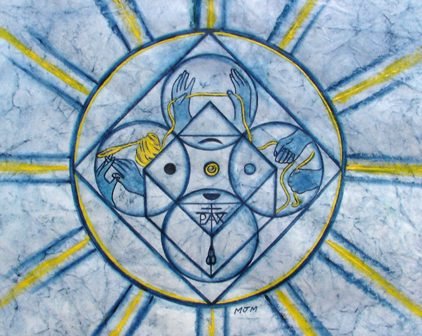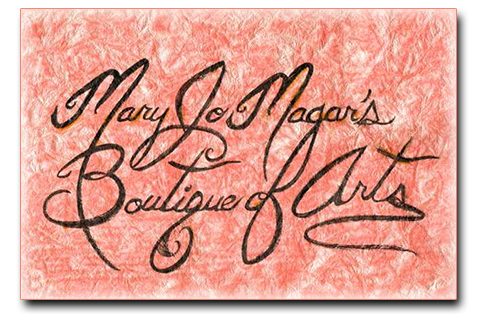
“The Moerae: Sal-Sol-Silk”
first prize, premier exhibit, 2007 Silk Arts Symposium, Krasnoyarsk, Russia
painted in woad and weld plant dyes on wild silk, which I hand batiked with woad and salt.
Common to many cultures and mythologies is portrayal of the “Fates” as weavers, and depiction of life’s thread as silk, which has the same protein matrix as human skin and hair, hence, the reason, in addition to strength, that silk has a long history of medical use for sutures. Silk is often referred to as the only fabric that is “second skin.” It has often also been referred to as “second soul” by emperors, high priests, and warriors, such as the ancient samurai who believed that wearing silk armored their souls against attack.
Both silk and salt have a crystalline structure and are piezoelectric, meaning that they possess electrostatic potential in response to mechanical stimulus.
In the center of the Sal-Sol-Silk design is the Platonic cube formation of crystalline natural salt constructed from “light quanta” (photons) that evaporated primal oceans over 250 million years ago and remain stored in the crystalline grid of salt as potential energy; when water, including the human body’s water, dissolves natural salt, this primal energy is liberated.
Just as sunlight forms a part of natural salt’s emergence from the dark (indigo) depths of ocean water, so too is sunlight a defining property of silk, which emerges from respective ovoid and cocooned darkness.
Light, whether natural or artificial, constantly influences the physiology of silkworms, which are highly photosensitive and tend to crawl towards light, though, like people, they require periods of alternate light and darkness to be healthy.
Rudolf Steiner described silk as “cosmic sunlight interwoven with matter,” and indeed, no fabric on earth plays with sunlight as silk does, particularly when dyed in the colors of nature.
In natural dye work, salt is commonly used as an “assist” to prepare fibers for accepting dye more readily, and in silk art, exquisite effects can be achieved using salt crystals with dyes to create patterns, e.g., the Sal-Sol-Silk design.
Silk, like salt, absorbs sunlight, which accounts for its effectiveness as a natural sunscreen.
Also depicted in the Sal-Sol-Silk design are the four lunar phases and the ancient Roman emblem for peace, referring to the wild “peace” silk presented here in the therapeutic colors of woad and weld, which are wholly plant derived and therefore grown with sunlight, which remains ingredient to the dyes.
Sal-Sol-Silk
– Mary Jo Magar –
How short the long horizon to sunrise
When, with outstretched hand, I can touch sunset
And grasp golden time in one silhouette
As sun and sea together in reprise,
One heaven and earth to dye and baptize
With sunlight salted with life to beget
Through play of colors in light’s fleet vignette,
And all for the sake of beauty through eyes.
What more to Creation’s design than this?
To bathe each day in auroral array
And make of the seas an indigo vat,
Weave silk of the world with each patterned ray,
Glisten at rise to set richly in matte,
Attire mere mortals in nature’s cachet.
“The Roman sun blazed gloriously overhead. The waters of the bay were bright blue. Horizontals and verticals danced in the distance. . . .
– from Wine, Women, and Woad by Ed Fisher –
“‘Tis true: there’s magic in the web of it: . . .
The sun to course two hundred compasses,
In her prophetic fury sew’d the work;
The worms were hallow’d that did breed the silk;
And it was dyed in mummy which the skilful
Conserved of maidens’ hearts.”
– from Othello, Act III, scene IV –
“And Judas returned to take the spoils of the camp, and they got much gold, and silver, and blue silk . . . ”
– Machabees 4:23 –
“. . . the butterfly-man exists, though as a matter of course, we cannot see him. . . . indeed, silkworms have all that they wish for, even considerably more. Their wants, though very simple, are fundamentally identical with the necessities of mankind: food, shelter, warmth, safety, and comfort. Our endless social struggle is mainly for these things. Our dream of heaven is the dream of obtaining them free of cost in pain; and the condition of silkworms is the realization, in a small way, of our imagined Paradise.”
– Anonymous –
